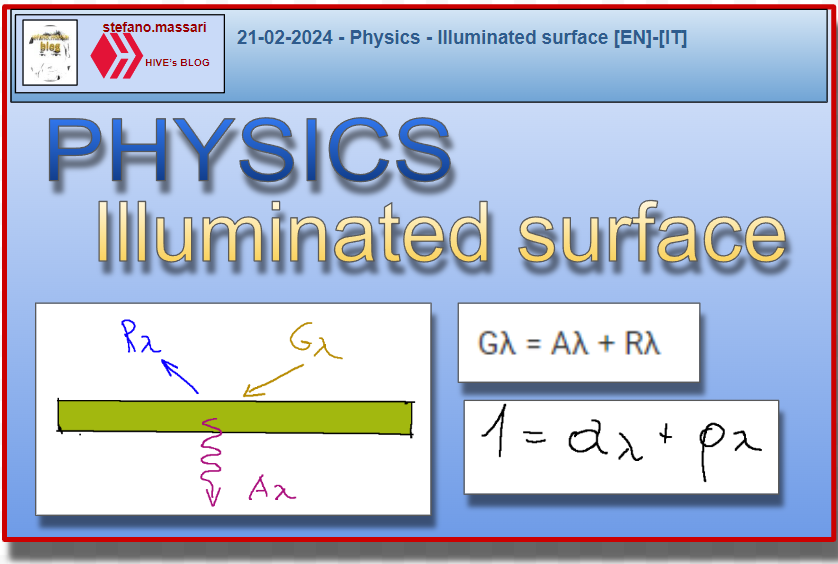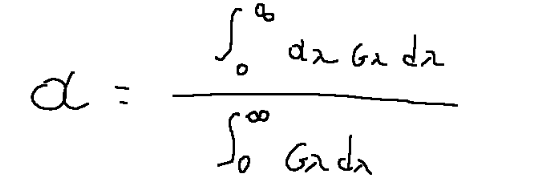21-02-2024 - Physics - Illuminated surface [EN]-[IT]
hive-146620·@stefano.massari·
0.000 HBD21-02-2024 - Physics - Illuminated surface [EN]-[IT]
 --- *~~~ La versione in italiano inizia subito dopo la versione in inglese ~~~* --- **ENGLISH** 21-02-2024 - Physics - Illuminated surface [EN]-[IT] **Basic concepts** In thermodynamics there are some basic concepts that are always good to keep in mind. Below are two of the most classic when we talk about thermodynamic cycles. What is the difference between a refrigerator and a heat pump? -The refrigerator is a system in which the SET A temperature is controlled, the heat pump is a system in which the SET B temperature is controlled. -The coefficient of useful effect of the refrigerator (εf) is equal to the thermal energy removed from the heat reservoir at a lower temperature with the work L on the mechanical energy supplied. ***Illuminated surface*** To understand the absorption of an illuminated surface we must remember some things, below are the factors to keep in mind. Gλ = radiant energy that affects the surface of a body Rλ = reflected radiation Aλ = absorbed radiation Tλ = transmitted radiation The mathematical relationship that indicates how much radiant energy affects the surface of a body is the following. Gλ = Aλ + Rλ + Tλ For the case study of an illuminated surface we take the case of an opaque body, i.e. the case in which the transmitted radiation is zero (Tλ=0) At this point we return to the formula of the radiant energy that affects the surface of a body seen before. Gλ = Aλ + Rλ + Tλ Remembering that Tλ = 0 becomes like this Gλ = Aλ + Rλ We can now draw our opaque body by noting the radiation at play in this case.  ελ is the ratio between the radiant energy emitted by a real surface at temperature T sup, wavelength λ, per unit area and time, and the radiant energy that would be emitted by a black surface in the same conditions. In this case we have that ελ = αλ This means that if ελ is known, the monochromatic absorption and reflection coefficients are also known. Therefore for an opaque body the following relation holds  Where: αλ = absorption coefficient ρλ = reflection coefficient For the relative total quantities we will have the following relationships:   **Conclusions** We can deduce that both α and ε do not depend on the wavelength. **Request** When we talk about making a home energy efficient we start talking about opaque bodies. Have you already heard of opaque bodies when it comes to housing? --- https://images.hive.blog/1536x0/https://files.peakd.com/file/peakd-hive/green77/gGQutTRs-hive-spacer.png --- 21-02-2024 - Fisica - Superficie illuminata [EN]-[IT] **Concetti base** Nella termodinamica ci sono alcuni concetti base che è sempre bene tenere in mente. Qui di seguito due tra i più classici quando parliamo di cicli termodinamici. Che differenza c'è tra frigorifero e pompa di calore? -Il frigorifero è un sistema in cui viene controllata la temperatura SET A, la pompa di calore è un sistema in cui è controllata la temperatura SET B. -Il coefficiente di effetto utile del frigorifero (εf) è uguale all'energia termica sottratta al serbatoio termico a temperatura inferiore con il lavoro L sull'energia meccanica fornita. ***Superficie illuminata*** Per capire l’assorbimento di una superficie illuminata dobbiamo ricordare alcune cose, qui di seguito i fattori da tenere in mente. Gλ = energia raggiante che incide sulla superficie di un corpo Rλ = radiazione riflessa Aλ = radiazione assorbita Tλ = radiazione trasmessa La relazione matematica che indica quanto è l’energia raggiante che incide sulla superficie di un corpo è la seguente. Gλ = Aλ + Rλ + Tλ Per il caso studio di una superficie illuminata prendiamo il caso di un corpo opaco, cioè il caso in cui la radiazione trasmessa è zero (Tλ=0) A questo punto riprendiamo la formula dell’energia raggiante che incide sulla superficie di un corpo vista prima. Gλ = Aλ + Rλ + Tλ Ricordando che che Tλ = 0 diventa così Gλ = Aλ + Rλ Possiamo ora disegnare il nostro corpo opaco annotando le radiazioni in gioco in questo caso.  ελ è il rapporto tra l’energia raggiante emessa da una superficie reale a temperatura T sup, lunghezza d’onda λ, per unità di area e di tempo, e l’energia raggiante che sarebbe emessa da una superficie nera nelle stesse condizioni. In questo caso abbiamo che ελ = αλ Questo significa che noto ελ, sono noti anche il coefficiente di assorbimento e quello di riflessione monocromatico. Quindi per un corpo opaco vale la seguente relazione  Dove: αλ = coefficiente di assorbimento ρλ = coefficiente di riflessione Per le relative grandezze totali avremo le seguenti relazioni:   **Conclusioni** Possiamo dedurre che sia α che ε non dipendono dalla lunghezza d’onda. **Domanda** Quando si parla di efficientamento energetico di una casa si inizia a parlare di corpi opachi. Avete già sentito parlare di corpi opachi quando si entra nel discorso abitazioni? **THE END**
👍 pab.ink, healthymary, dexpartacus, hardrockcrypto, samubit, garlet, voter, nainaztengra, libertycrypto27, cryptomonica, sportgamer, axel-blaze, meppij, libertypob27, nftfrappe, spurisna, libertypal27, ilcontabile, sweetunicorn, clifth, pixresteemer, kork75, libertyctp27, pensieristupendi, libertyleo27, blumela, grapthar, taimen, stea90, lorenzopistolesi, da-dawn, new-world-steem, hivepakistan, splash-of-angs63, amjadsharif, lifeskills-tv, cwow2, dlmmqb, astrocat-3663, cryptohaytham, ak08, tehseen-akhtar, idksamad78699, faiza34, mishkatfatima, ukrajpoot, foodchunk, tahastories1, les90, wallay, ismartboy, sahi1, quduus1, ayesha-malik, shawnnft, husnainyousaf, he-index, newsposter, elianaicgomes, irivers, holovision.stem, drlobes, rafzat, hive-129556, peerfinance, bencwarmer, giuatt07, lupega, waivio.welcome,